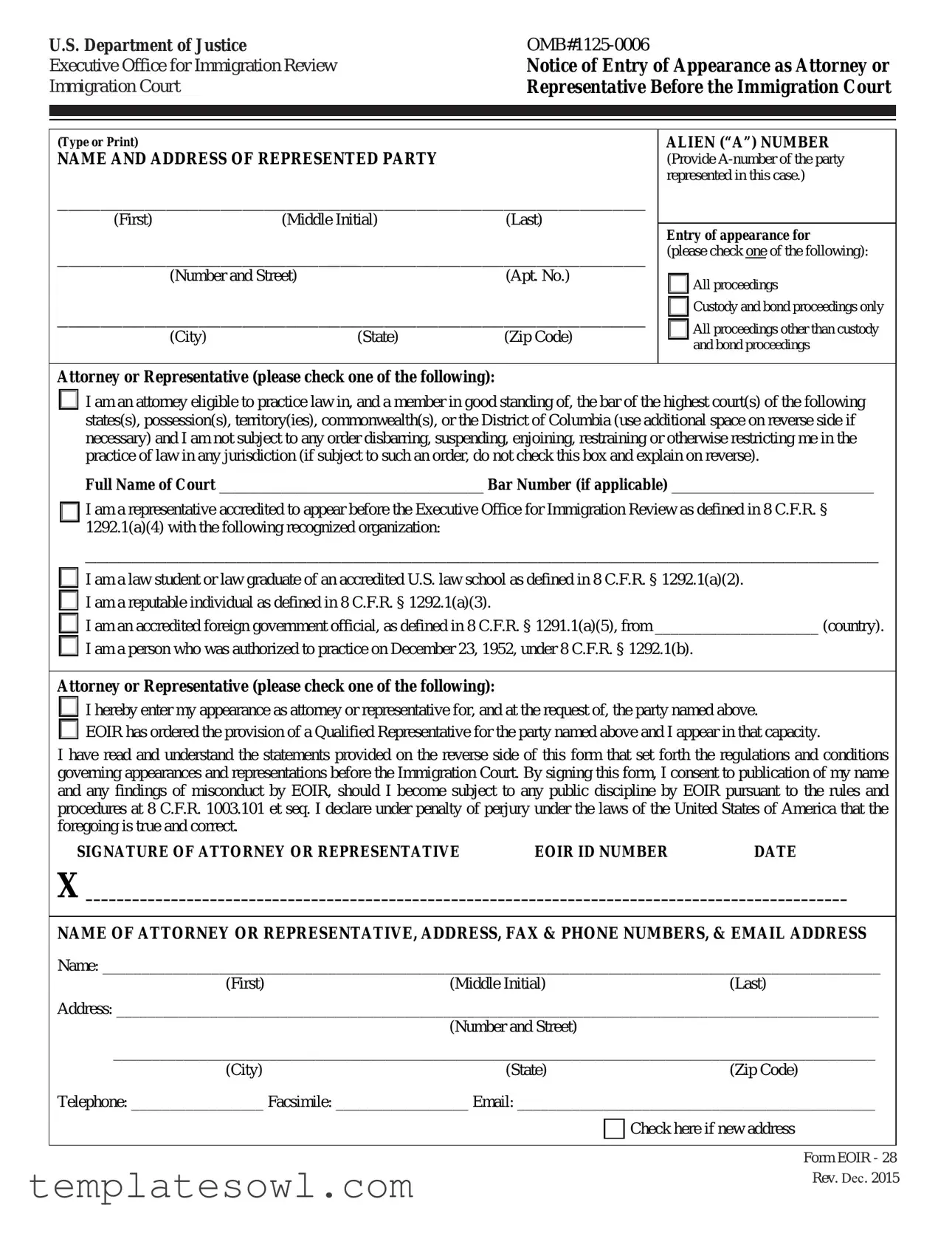U.S. Department of Justice |
OMB#1125-0006 |
Executive Office for Immigration Review |
Notice of Entry of Appearance as Attorney or |
Immigration Court |
Representative Before the Immigration Court |
|
|
|
|
|
|
(Type or Print)
NAME AND ADDRESS OF REPRESENTED PARTY
______________________________________________________
(First)(Middle Initial)(Last)
______________________________________________________
(Number and Street)(Apt. No.)
______________________________________________________
(City) |
(State) |
(Zip Code) |
ALIEN (“A”) NUMBER
(Provide A-number of the party represented in this case.)
Entry of appearance for
(please check one of the following):
All proceedings
Custody and bond proceedings only
All proceedings other than custody and bond proceedings
Attorney or Representative (please check one of the following):
I am an attorney eligible to practice law in, and a member in good standing of, the bar of the highest court(s) of the following states(s), possession(s), territory(ies), commonwealth(s), or the District of Columbia (use additional space on reverse side if necessary) and I am not subject to any order disbarring, suspending, enjoining, restraining or otherwise restricting me in the practice of law in any jurisdiction (if subject to such an order, do not check this box and explain on reverse).
Full Name of Court __________________________________ Bar Number (if applicable) __________________________
I am a representative accredited to appear before the Executive Office for Immigration Review as defined in 8 C.F.R. § 1292.1(a)(4) with the following recognized organization:
____________________________________________________________________
I am a law student or law graduate of an accredited U.S. law school as defined in 8 C.F.R. § 1292.1(a)(2). I am a reputable individual as defined in 8 C.F.R. § 1292.1(a)(3).
I am an accredited foreign government official, as defined in 8 C.F.R. § 1291.1(a)(5), from _____________________ (country).
I am a person who was authorized to practice on December 23, 1952, under 8 C.F.R. § 1292.1(b).
Attorney or Representative (please check one of the following):
I hereby enter my appearance as attorney or representative for, and at the request of, the party named above.
EOIR has ordered the provision of a Qualified Representative for the party named above and I appear in that capacity.
I have read and understand the statements provided on the reverse side of this form that set forth the regulations and conditions governing appearances and representations before the Immigration Court. By signing this form, I consent to publication of my name and any findings of misconduct by EOIR, should I become subject to any public discipline by EOIR pursuant to the rules and procedures at 8 C.F.R. 1003.101 et seq. I declare under penalty of perjury under the laws of the United States of America that the foregoing is true and correct.
SIGNATURE OF ATTORNEY OR REPRESENTATIVE EOIR ID NUMBER DATE
X __________________________________________________________________________________________________
NAME OF ATTORNEY OR REPRESENTATIVE, ADDRESS, FAX & PHONE NUMBERS, & EMAIL ADDRESS
Name: ____________________________________________________________________________________________________
(First)(Middle Initial)(Last)
Address: __________________________________________________________________________________________________
(Number and Street)
__________________________________________________________________________________________________
(City)(State)(Zip Code)
Telephone: _________________ Facsimile: _________________ Email: ______________________________________________
Check here if new address
Form EOIR - 28 Rev. Dec. 2015
Indicate Type of Appearance:
Primary Attorney/Representative Non-Primary Attorney/Representative
On behalf of ______________________________ (Attorney’s Name) for the following hearing: _________________ (Date)
I am providing pro bono representation. Check one: yes no
Proof of Service
I (Name) _____________________________ mailed or delivered a copy of this Form EOIR-28 on (Date) __________________
to the DHS (U.S. Immigration and Customs Enforcement – ICE) at _________________________________________________
X ___________________________________________________________
Signature of Person Serving
APPEARANCES - An attorney or Accredited Representative (with full accreditation) must register with the EOIR eRegistry in order to practice before the Immigration Court (see 8 C.F.R. § 1292.1(f)). Registration must be completed online on the EOIR website at www.justice.gov/eoir. An appearance shall be filed on a Form EOIR-28 by the attorney or representative appearing in each case before an Immigration Judge (see 8 C.F.R. § 1003.17). A Form EOIR-28 shall be filed either as an electronic form, or as a paper form, as appropriate (for further information, please see the Immigration Court Practice Manual, which is available on the EOIR website at www.justice.gov/eoir). The attorney or representative must check the box indicating whether the entry of appearance is for custody and bond proceedings only, for all proceedings other than custody and bond, or for all proceedings including custody and bond. When an appearance is made by a person acting in a representative capacity, his/her personal appearance or signature constitutes a representation that, under the provisions of 8 C.F.R. part 1003, he/she is authorized and qualified to represent individuals and will comply with the EOIR Rules of Professional Conduct in 8 C.F.R. § 1003.102. Thereafter, substitution or withdrawal may be permitted upon the approval of the Immigration Judge of a request by the attorney or representative of record in accordance with 8 C.F.R. § 1003.17(b). Please note that although separate appearances in custody and non-custody proceedings are permitted, appearances for limited purposes within those proceedings are not permitted. See Matter of Velasquez, 19 I&N Dec. 377, 384 (BIA 1986). A separate appearance form (Form EOIR-27) must be filed with an appeal to the Board of Immigration Appeals (see 8 C.F.R. § 1003.38(g)). Attorneys and Accredited Representatives (with full accreditation) must first update their address in eRegistry before filing a Form EOIR-28 that reflects a new address.
FREEDOM OF INFORMATION ACT - This form may not be used to request records under the Freedom of Information Act or the Privacy Act. The manner of requesting such records is in 28 C.F.R. §§ 16.1-16.11 and appendices. For further information about requesting records from EOIR under the Freedom of Information Act, see How to File a Freedom of Information Act (FOIA) Request With the Executive Office for Immigration Review, available on EOIR's website at http://www.justice.gov/eoir.
PRIVACY ACT NOTICE - The information requested on this form is authorized by 8 U.S.C. §§ 1229(a), 1362 and 8 C.F.R. § 1003.17 in order to enter an appearance to represent a party before the Immigration Court. The information you provide is mandatory and required to enter an appearance. Failure to provide the requested information will result in an inability to represent a party or receive notice of actions in a proceeding. EOIR may share this information with others in accordance with approved routine uses described in EOIR's system of records notice, EOIR-001, Records and Management Information System, 69 Fed. Reg. 26,179 (May 11, 2004), or its successors and EOIR-003, Practitioner Complaint-Disciplinary Files, 64 Fed. Reg. 49237 (September 1999). Furthermore, the submission of this form acknowledges that an attorney or representative will be subject to the disciplinary rules and procedures at 8 C.F.R. 1003.101et seq., including, pursuant to 8 C.F.R. §§ 292.3(h)(3), 1003.108(c), publication of the name of the attorney or representative and findings of misconduct should the attorney or representative be subject to any public discipline by EOIR.
CASES BEFORE EOIR - Automated information about cases before EOIR is available by calling (800) 898-7180 or (240) 314-1500.
FURTHER INFORMATION - For further information, please see the Immigration Court Practice Manual, which is available on the EOIR website at www.justice.gov/eoir.
ADDITIONAL INFORMATION:
Under the Paperwork Reduction Act, a person is not required to respond to a collection of information unless it displays a valid OMB control number. We try to create forms and instructions that are accurate, can be easily understood, and which impose the least possible burden on you to provide us with information. The estimated average time to complete this form is six (6) minutes. If you have comments regarding the accuracy of this estimate, or suggestions for making this form simpler, you can write to the Executive Office for Immigration Review, Office of the General Counsel, 5107 Leesburg Pike, Suite 2600, Falls Church, Virginia 22041.
Form EOIR - 28
Rev. Dec. 2015


